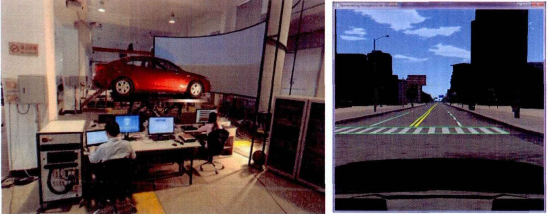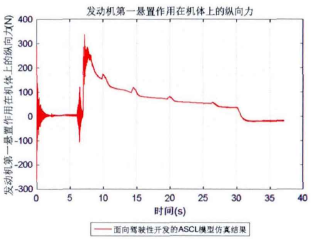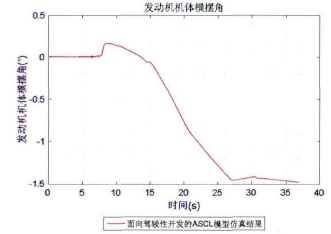摘要
驾驶性是汽车产品的核心竞争力之一,是目前国内外研宄热点。是指汽车纵向行驶过程中,驾驶员控制车辆响应的容易程度以及对车辆响应感觉的舒适程度,主要包括驾驶员易操控性、驾驶过程中驾驶舒适性、驾驶员体感、驾驶员路感。车速的提高,发动机动力的增强,变速器换档、离合器结合的冲击,都会使得车体抖振加剧,甚至导致传动轴、仪表盘等总成部件的共振,这些种种不良现象会严重影响车辆的驾驶舒适性。当前汽车制造商主要在汽车产品开发流程后期,根据场地实车实验由评车师的驾驶性主观评价来指导汽车设计,开发成本较高,试验周期较长。建立面向驾驶性的动力传动准瞬态实时模型,并依托驾驶模拟器进行驾驶性主观评价,可以将驾驶性的研究提前到预开发阶段。
面向驾驶性研宄的动力传动系统模型需要满足以下需求.?模型能够实时仿真驾驶性相关瞬态现象,能够仿真驾驶性相关的体感,能够支持硬件在环仿真和多学科混合仿真。现有的汽车实时动力学商业软件中,发动机模型大多是基于MAP图的稳态模型,发动机扭矩与曲轴转角位置不相关,发动机悬置处的力与曲轴扭矩不同相位,导致动力传动系对底盘的高频激励输入相位不一致;将油门踏板位置直接当作节气门输入,不能描述推背感等驾驶感觉。因此这些模型无法实现在汽车开发流程前期进行车辆驾驶性仿真与评价,从而无法为动力传动系统相关总成部件和功能部件的设计与匹配提供依据。
近些年,课题组在动力传动系统建模方面进行了大量的探索研宄,积累了不少经验,同时课题组有着发展很成熟的整车动力学模型。大量实车场地试验验证了其稳态性能与实车稳态性能一致。为了进一步研究动力传动系统的瞬态过程对整车性能的影响,本文调研了国内外当前动力传动系统模型发展现状,在此基础上总结了面向驾驶性的动力传动系统建模相关的关键问题,并针对这些关键问题做了如下的研宄工作:
首先,为描述并实时仿真因缸内压力高频激励而引起的曲轴扭矩波动以及悬置力对车体激励力的同相位特征,在原有稳态模型基础上,本文提出了基于示功图的发动机瞬态扭矩模型。该模型能够更为准确的仿真发动机气缸波动产生的高频激励。并且建立了发动机曲柄连杆机构静力学模型、平衡轴模型、发动机机体动力学模型,能够同时同相位输出悬置力,且能够更加准确地描述悬置力对车体的激励。
其次,针对驾驶体感的主观评价需要更加真实地描述加速踏板操纵下的加速度瞬态响应,本文建立了面向驾驶体感的发动机虚拟电控系统模型。模型包含计算并协调发动机外部扭矩需求模块(驾驶员、巡航控制、变速器控制等),以及发动机内部扭矩需求模块(怠速控制、附件损失、催化剂加热等),从而决策出快通道的扭矩需求和慢通道的扭矩需求,进一步将不同通道的扭矩需求转化成相应的控制量(节气门、喷射时间、点火提前角)。相对于原有的发动机模型,此模型更为有效的模拟了真实发动机电控系统的扭矩决策,从而更为有效地模拟了驾驶体感。同时,虚拟EMS模型可以服务于动力传动控制系统的前期标定并且支持其他控制系统的同步标定。
再次,开展了动力传动系统模块化分解关键问题研宄。为了实现动力传动硬件在环仿真以及多学科联合仿真,以及模型升级和替换方便,并且提升模型仿真计算效率,对动力传动系统进行了模块化分解。先将动力传动模型按照汽车结构拆分成发动机、变速器箱等总成,各大总成继续分解为部件。各大总成内部由于复杂程度不同会使仿真频率有所差异,为了解决由此产生的刚性方程问题,本文采用了多速率Runge-Kutta与Rosen-Brock结合的积分方法进行求解,可以有效地提高仿真效率、稳定性以及精度。
最后,将本文动力传动系统模型集成到整车模型中进行实车场地客观验证。进行驾驶性相关瞬态过程的离线仿真,将本文所建模型与原有模型进行仿真对比,结果表明该模型对汽车瞬态过程仿真能力有着明显的提升。同时,将该模型集成到驾驶模拟器中,并嵌入成熟的国际商业软件WAVE-RT燃烧模型,进行模拟器驱动下的动力传动系统硬件在环仿真。仿真结果表明,本文模型相比于原有模型在驾驶性相关的汽车瞬态过程中使驾驶员具有更为逼真的驾驶体感,模型明显提升了对汽车瞬态过程的仿真能力,从而更为有效地在预开发阶段进行驾驶性主观评价。
关键词:驾驶性,准瞬态,模块化,发动机虚拟电控系统,动力传动系统模型
ABSTRACT
Drivability is one of the core competitiveness of automotive products, but also the current research hotspot. It refers to the ease degree that drivers control the vehicle response and the comfort of the vehicle response during the longitudinal driving process, including the driver easy handling, driving comfort, the driver's somatosensory, the driver's road feeling.
The increase of vehicle speed, the increase of engine power, the shift of the transmission and the impact of the clutch combination will make the body tremble intensified, and even lead to resonance of the transmission shaft, dashboard and other assembly parts. These adverse phenomena will seriously a£Fect the vehicle driving comfort. At present, in the later stage of the automobile product development, the automobile manufacturer designs the vehicle guided by the driver's subjective evaluation of the drivability according to the actual vehicle xperiment. It is an effective way to carry out the research on drivability by establishing the quasi-transient real time model of power transmission carring out driver's subjective evaluation based on driving simvilator.
Powertrain system model for vehicle drivability research needs to meet the following requirements: The model can simulate the transient phenomena associated with the drivability in real time. The model can simulate the drivability related road feeling and somatosensory. The model supports hardware in the loop simulation and multi-disciplinary hybrid simulation. The existing commercial software in real-time vehicle dynamics, the steady-state engine model model based on MAP diagram lead to the engine torque is not related to the crank angle position; the different phase of the engine mount force and the crankshaft torque leads to the high frequency excitation phase that the power transmission system input to the chassis is inconsistent; It can not describe the push back feeling and other driving feeling taken the accelerator pedal position as a throttle input. Therefore, these models can not be used to carry out vehicle drivability simulation and evaluation in the early stage of the automobile development process, so as to not be able to provide the basis for the design and matching of relevant components and functional components of the powertrain system.
In recent years, the research group has done a lot of research on the modeling of the powertrain system^ and accumulated a lot of experience. At the same time,the research group has a very mature vehicle dynamics model. A large number of real vehicle field tests verify that its steady-state performance is consistent with real vehicle steady-state performance. In order to further study the influence of the transient process of the powertrain system on the performance of the vehicle, the current development status of the powertrain system model at home and abroad is investigated in this paper. On this basis, the key problems related to the modeling of powertrain system for vehicle drivability is summarized.
The following research work on these key problems are carried out:
Firstly, in order to describe and real-time simulate the crankshaft torque fluctuation caused by the high frequency excitation in the cylinder and the same phase characteristic of the mounting force on the vehicle body, based on the original model, the engine transient torque model based on the indicator diagram is presented to simulate the high frequency excitation generated by the fluctuation of engine cylinder more accurately. The engine crajok-link mechanism statics model, the balance axis model, the engine body dynamics model are established to simultaneously output the the mounting force with the same phase and more accurately described the excitation for the vehicle body.
Secondly,the evaluation for driving somatosensory requires a more realistic description of the acceleration transient response with the accelerator pedal operation. Therefore, a virtual engine control system model for driving somatosensory is established. The model includes the modules of the calculation and coordination of the engine external torque demand (driver, cruise control, transmission control, etc.) as well as the engine internal torque demand module (idle control, loss of accessories, catalyst heating, etc.)to determine the the fast channel torque requirements and slow Channel torque requirements and fUrther to convert the different channel torque requirements into the corresponding control variables (throttle, injection time, ignition advance angle). The model is more effective to simulate the driving somatosensory, and can be used in the pre-calibration of the powertrain control system and the synchronization calibration of other control systems.
Thirdly,the key problems research on the powertrain system modular decomposition is carried out In order to realize powertrain hardware in the loop simulation and multi-disciplinary Co-simulation, at the same time in order to upgrade and replace the model easily, and in order to improve the computational efficiency of simulation model, modular decomposition of powertrain system is carried out. The powertrain model is divided into the engine, gearbox and other assemblies according to the vehicle structure, and each assembly continues to be divided into components. In this paper, based on the existing numerical integration methods, the multi-rate Runge-Kutta and Rosen-Brock combined method with high stability and efficiency is proposed.
Finally, the powertrain model built in this paper is integrated into the vehicle model for objective verification. The transient simulation of the driving process is carried out, and the simulation results of the model and the traditional model are compared. The results show that the model can obviously improve the transient simulation ability of the vehicle. At the same time, the model is integrated into the driving simulator, and co-simulates with the international mature commercial software. Powertrain system hardware in the loop simulation driven by a driving simulator is carried out. Compared with the traditional model, the difiference of the subjective feeling of driver in the drivability related transient process between the model and the traditional model further shows that the model can enhance the simulation ability of the vehicle transient process and realize the more efifective drivability subjective evaluation.
Keywords: drivability, quasi-transient, modular, virtual engine electronic control system, powertrain system model
驾驶舒适性、驾驶员体感、路感等是汽车驾驶性的主要评价内容。随着车速的提高,发动机动力增强,驾驶过程中的抖振、摆振及推背感等会影响汽车驾驶性,因此驾驶性成为汽车产品的核心竞争力之一。当前,汽车驾驶性主要依靠实车场地试验进行主观评价,开发风险大。如果在产品开发初期,利用驾驶模拟器进行驾驶性评价则可以大大缩短开发周期,降低开发风险。因此,面向驾驶性的动力传动系实时动力学模型开发是当前国际研宄的热点之一。
现有的实时汽车动力学商业软件中的动力传动系统模型,不能很好地支持驾驶性研宄。具体表现在:发动机模型大多是基于MAP图的稳态模型,发动机扭矩与曲轴转角位置不相关,发动机悬置处的力与曲轴扭矩不同相位,导致动力传动系对底盘的高频激励输入相位不一致;多数模型将油门踏板位置直接作为节气门输入,不能描述推背感等驾驶感觉。面向驾驶性主观评价,本文进行了动力传动系统准瞬态建模研宄,其中包括建立基于示功图的发动机准瞬态模型,建立虚拟发动机电控单元,以及针对嵌入式开发进行动力传动系统模型模块化分解的关键问题研究。本文主要研宄内容如下:
基于示功图的准瞬态发动机模型。针对传统的发动机输出扭矩仅与转速有关而与转角位置无关的问题,本文提出采用示功图建立发动机模型,实现了曲轴扭矩随转角720度波动特性的实时仿真,同时得到与发动机扭矩相位一致的悬置力,实现了动力传动系统对底盘髙频激励输入,描述了驾驶过程中的瞬态现象。
面向驾驶体感仿真的发动机虚拟电控单元建模。以往的模型缺乏电控单元控制策略,类似于一个化油器式发动机,导致同一加速踏板位置对应的加速度与实车差异较大。为此,本文建立发动机虚拟电控系统模型,能够仿真车辆加速度在加速踏板操纵下的瞬态响应,实现了驾驶体感的准确模拟。
动力传动系统模块化分解。本文将所搭建的动力传动系统模型根据工程师需求按照实际汽车结构进行模块化分解,实现了模型的开放和多学科混合仿真,使得局部模块可以按需关闭,从而使外部模块替换局部模块,并且支持硬件实物或其他商业软件模型的嵌入。
按照上述技术路线,本文成功搭建了一套准瞬态动力传动模型。将所建模型与国际成熟发动机商业软件WAVE-RT燃烧模型联合仿真,并将其与驾驶模拟器以及dSPACE组成集成的硬件在环实时仿真平台。在此软硬件集成平台上,进行实时仿真,并将仿真结果与原有的动力传动系统性能模型对比。结果表明本文所建模型能够激发出更多的瞬态现象,而且能够体现驾驶员真实的驾驶体感,可以用来进行汽车驾驶性研究。
汽车驾驶性的动力传动系统:

汽车驾驶性的动力传动系统

中油n(50%)工况下发动机第一悬置作用在机体上的纵向力

中油门(50%)工况下发动机机体横摆角
目录
第1章 绪论
1.1 课题的提出
1.2 发动机建模相关研究综述
1.2.1 发动机气动和燃烧模型的类型及应用
1.2.2 发动机机械动力学模型及应用
1.3 面向驾驶性的汽车发动机电控管理系统研究现状
1.4 传动系建模研究综述
1.4.1 传动系统模型回顾
1.4.2 现有车辆动力学商业软件中传动系建模现状
1.5 本文主要研究内容
第2章 基于示功图的发动机准瞬态实时模型研究
2.1 引言
2.2 基于示功图的发动机准瞬态模型架构
2.3 基于示功图的发动机燃烧压力模型
2.4 发动机机械动力学模型解耦条件理论推导
2.5 发动机机械动力学模块化模型
2.5.1 发动机曲柄连杆机构建模
2.5.2 发动机曲轴旋转动力学建模
2.5.3 发动机机体动力学模型
2.6 发动机悬置功能部件模型
2.7 本章小结
第3章 面向驾驶性的发动机虚拟电控系统功能建模
3.1 引言
3.2 基于扭矩控制的发动机电控管理系统基本功能
3.3 面向驾驶性研究的发动机虚拟电控模型整体框架
3.4 扭矩计算模型
3.4.1 驾驶员扭矩需求
3.4.2 扭矩限值模块
3.4.3 扭矩损失模块
3.4.4 扭矩计算辅助模块
3.5 扭矩协调模型
3.6 扭矩转化模型
3.7 本章小结
第4章 基于总成特性的汽车传动系统实时模型建模
4.1 引言
4.2 机械系统几种典型的模块化分割方法及在动力传动系统的应用.57
4.3 动力传动系统扭转运动相分析
4.4 带锁止离合器的液力变矩器模型
4.4.1 液力变矩器泵轮和涡轮力矩计算
4.4.2 液力变矩器中锁止离合器摩擦状态判断
4.4.3 液力变矩器中锁止离合器摩擦力矩计算
4.4.4 液力变矩器输入端和输出端计算
4.5 行星齿轮自动变速器模型
4.6 传动系扭转弹性等效单元模型
4.7 基于特性的主减速器、差速器模型
4.8 万向节模型
4.8.1 十字轴万向节
4.8.2 等速万向节
4.9 车轮旋转动力学模型
4.10 起动机模型
4.11 基于模块化建模的多速率积分求解方法
4.11.1 多速率 RK-Rosenbrock 法
4.11.2 多速率RK-Rosenbrock方法的相容阶
4.12 本章小结
第5章 汽车动力传动与底盘集成及仿真验证
5.1 引言
5.2 模型多速率积分实时性验证
5.3 汽车动力传动系统模型与底盘动力学模型集成
5.4 动力传动与底盘集成模型场地实验验证
5.4.1 滑行工况
5.4.2 连续换挡加速工况
5.4.3 双移线工况
5.5 驾驶模拟器驱动的驾驶性主观评价硬件在环仿真平台搭建与仿真
5.5.1 Tip in/Tip out 工况仿真
5.5.2 怠速工况仿真
5.5.3 低速驾驶
5.6 本章小结
第6章 全文总结和研究展望
6.1 全文总结
6.2 研究展望
参考文献
致谢
(如您需要查看本篇毕业设计全文,请您联系客服索取)